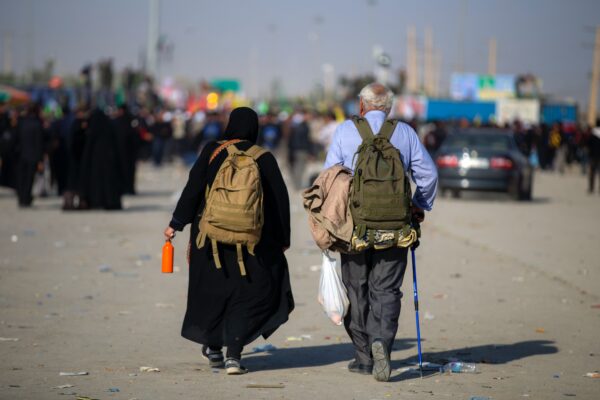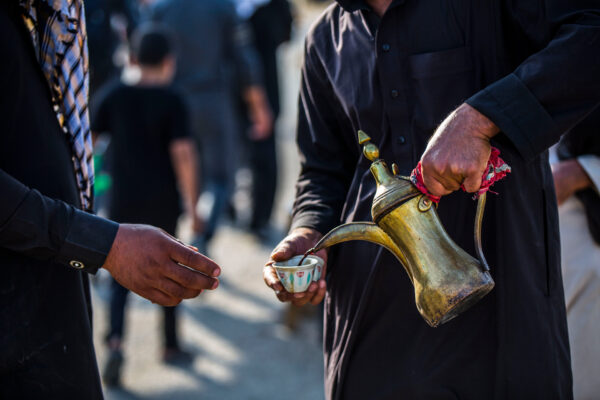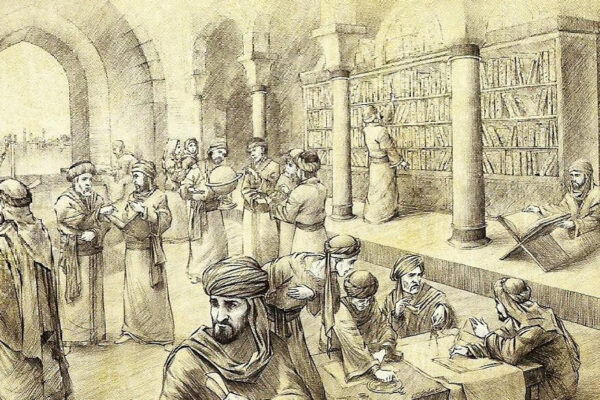Whats interesting to me is that this struggle isn’t only significant for people who live their daily lives in Iraq. This revolution is also for those of us outside of Iraq…always longing to return, living in our nostalgias and traumas. It is for the Iraqis that have been robbed of a land to return to.
Iraq is Healing: The October Revolution, Systemic Change and Intergenerational Trauma
Whats interesting to me is that this struggle isn’t only significant for people who live their daily lives in Iraq. This revolution is also for those of us outside of Iraq…always longing to return, living in our nostalgias and traumas. It is for the Iraqis that have been robbed of a land to return to.
I am writing this as a daughter of the Iraqi Diaspora, in English, to bridge the gap between what is happening on the ground in Iraq and the international community. The lack of media coverage is in stark contrast to the plethora of powerful content circulating from Iraqis on the ground on social media. The stories, the images, and the symbolic centres of the revolution need to be heard, seen, held and celebrated because they have the potential to inspire all of our collective struggles. They deserve our support.
The revolution under way in Iraq is highly symbolic, because it is greater than the sectarian narrative that we have been fed throughout the years. The Iraqi narrative, since the illegal US-led war and occupation in 2003, has been crafted by the people who benefit from its instability, and made into a complicated mess that is difficult to articulate. This time, however, this is not the case. There is something deeper brewing, and it has to do with all of us. It has to do with the deep impact of colonialism, imperialism, and corrupt systems disguised as democracy. It has to do with systemic change, from the inside out.
Since October 25, the people of Baghdad have taken over Tahrir square, the highly symbolic centre of the city, home to Jawad Salim’s iconic Nasb Al Hurriya (the Freedom Monument). Their demands are simple. Nreed Watan. We want a country. They are there to hold the government accountable. Ultimately, they want to break the system, because its already broken.
The protests have been peaceful; the government response vicious. Over 250 protestors have been killed since the protests began on Oct 1, and thousands injured. Demonstrations are happening all over Iraq, from Basra to Najaf. In Karbala alone, 18 protesters were killed in one night. In Baghdad, government Special Forces, dressed in black, have been attacking unarmed protestors with military-grade tear gas, expired since 2014, and the cans themselves have been killing and injuring scores of people by getting lodged in the head and other vital organs. The people have been responding by concocting home-made remedies and pepsi to soothe the eye burns, with some brave youth even throwing the fuming canisters back at the army.
The iconic images of Iraqis old and young wearing blue surgical masks testifies to the overuse of this toxic gas to try to quell the demonstrations. It hasn’t worked, as millions of Iraqis are still taking to the streets demanding their right to live in dignity, in utter fearlessness. The people know how high the stakes are, both in terms of their own vulnerability to extreme violence, as well as the fragility of their corrupt government.
In one of the most oil-rich countries in the world (Iraq has the 5th largest oil fields in the world), the quality of life is devastatingly low. The unemployment rate is high; poverty is extreme, and the youth need jobs. Electricity is powered for 5–8 hours per day, the water is contaminated, and a failing medical system are only a few of the issues Iraqi’s are frustrated with. Politicians never keep any of their promises; restoration and service amelioration projects come and get squashed before the ink even dries, and the money allocated to them evaporates into dirty pockets.
Iraq is currently caught in a tug of war between foreign powers invested in controlling it’s political and economic landscape, between the US, Iran, Turkey, Saudi Arabia and others. Militias run amok, exercising a power rooted in violence. Iraq has great geopolitical significance, as well as its historic significance as the cradle of civilization, home to the earth’s first known civilization, the Sumerians. I believe that this land holds many keys in understanding our origin story, a history that has been continuously erased, ignored, and therefore repeated quite systematically.
Ultimately, the Iraqi people deserve a better life. They deserve to live in dignity, with a calibre of services and a quality of life that reflects the richness of the land and the depth of its history. Contrary to the popular hashtag, #save_the_iraqi_people, the people have proved that they don’t need anyone to swoop in and save them; they are up to the task themselves.
There are four main elements that have kept this revolution alive and pumping:
1) The peaceful protestors that have been flooding Tahrir Square day and night, night and day. In the hundreds of thousands, the people are feeding each other, cleaning the streets, dancing, singing, distributing blankets during the cold nights, and expressing a kind of community-care towards each other in a way never seen before. Besides the joyful energy, the protesters are holding space for the martyrs and the injured, holding vigils, lighting candles for them, and painting murals to immortalize the ones they have lost.
There are calls for people to be respectful of the realities of the struggle, of the martyrs and the wounded, by not treating this revolution as a photo-op and party. There is prayer. There is hope. There are women, of all ages and backgrounds, documenting, chanting, praying, cooking, tending to the injured, accompanying teenage sons, participating in the revolution. Pockets of community are everywhere, from barbers offering their services to the protesters, mini libraries offering books, mini soccer matches, card games, street poetry, to artists painting and drawing on walls.
Families go out together, from all classes and neighborhoods, defined by the hashtag نازل_اخذ_حقي# (I am coming down to demand my rights). Hoards of students have been leaving secondary schools and universities to join the protests, in uniform. Unions have joined the protest. Brave rescue workers and doctors are on the ground, with a young Iraqi female doctor, Selene Basil, coming home from France just to treat her people in the revolution. It is overwhelming, and many people are fainting and suffocating from the tear gas, needing oxygen and other urgent care. Birds are falling from the sky, poisoned by the fumes. There are stories on every face, every corner.
Social media influencers like @alinajm3, @tattooedsuperman, @ayamansour11 @adhamadil, @tbark_mansour and more, otherwise known for culture and art, have now become vital information sources in the revolution for the youth that follow them. Iraqi photographers like @zaid_mohammed14, @ghaith_abdulahad, @abdullalii @haider_husseinii, @aimhazi, @3addn, @ak_abbas01, @afiaa_rasheed, @aymanalamiri and more are bringing powerful stories and a human face to our struggle, in a way never done before. The underlying message that I keep hearing is that “sectarianism is over”. The people have had enough of this tired rhetoric that has kept them divided for so long. It was a military strategy, after all: divide and conquer. A people, united, will never be defeated. This is civil disobedience at its finest.
2) The Turkish Restaurant building, the high rise tower that looks over Tahrir Square and the Jumhuriya bridge (which leads to the Green Zone — more on that next) has become a powerful centre of the revolution. The building, which is in fact a shell of its former self, with openings instead of windows, and scaffolding on the sides of the building, has been unoccupied since 2003, before which it was a popular Turkish restaurant patroned by Uday Hussein. It is said that the snipers who killed dozens of protestors in the first wave of uprising in the first week of October were shooting from positions inside the Turkish Restaurant building. Therefore, it is a key strategic site, and the fact that protestors have occupied it, and are refusing to leave, means that they are in fact protecting the protestors on the ground. They are truly “holding down the fort”, and won’t budge.
Instead, they have worked out systems of getting provisions in and out of the building by suspending ropes on the sides of the building, and making requests via social media as per their current needs — whether it be blankets, food, or even cigarettes. They use lasers and lights as a way to deter any direct attacks at the building, and even use a loud speaker to communicate with the protestors on the bridges and on the ground. Most inspiring, artists have taken to painting the walls of the building and it’s surroundings, prompted by young Iraqi artist @sajjadabbas2 and others, with messages and images from within the revolution, and dozens of banners with messages of unity drape off the sides of the building. The building has been dubbed Jabal Uhud — Mount Uhud, in Medina, was a site of a historic Islamic battle during the days of the Prophet Muhammad. In the context of the current Iraqi revolution, this building represents a shift of power towards a righteous struggle, a protector.
3) The two bridges leading to the Green Zone — the Jumhuriyya bridge and the Sinak bridge — have seen the worst casualties of this revolution. There is a no-mans-land between the protestors on one side and the military barricade upon the bridge, from which special forces have been shooting military grade tear gas canisters at any protesters attempting to cross it. The Green Zone represents the seat of power for the Iraqi government and its imperial puppet masters, as that is where all the government buildings and embassies are located.
Protesters have been attempting to reach the Green Zone since the evening of October 24, and were faced with scalding water, rubber bullets, stun grenades and tear gas. It is important to note that the Green Zone is a controlled neighborhood at all times — meaning, the government has restricted its citizens from entering the Green Zone since the U.S. occupation in 2003. The Green Zone represents the breeding ground of corruption, and ultimately the protector of US imperial power, as represented in the massive US embassy, a symbol of American control of Iraq (and the region at large.)
The 750-million dollar embassy employs 16,000 people, and covers 142 acres of prime Baghdadi riverfront real-estate. Limiting the peoples mobility within one of the most important locations in the city of Baghdad, which runs along the banks of the river Tigris, is symbolic of the pardoning of American crimes against the Iraqi people, generations deep. It is also symbolic of the pool of money that exchanges hands amongst Iraq’s corrupt political elite, never making its way to the people, the city’s heritage, and the services in dire need of restoration and maintenance.
4) The brave boys and men who drive TukTuk’s have taken on the role of being front line rescue workers, transporting the injured to ambulances waiting for them, organizing a rescue system amidst the chaos of Tahrir square. Many tuktuk drivers are protecting their 3-wheeled vehicles with wire, to keep the riders safe from tear gas canisters being shot at them. They are some of the bravest and most fearless Iraqis, and have become symbols of the revolution, with their unstoppable courage and unrelenting pride. They, most importantly, come from deep within the Iraqi struggle, many of them having lost parents in the various wars, having to learn to depend on themselves in a crooked system while trudging through poverty. Since this revolution began, many have been refusing any money for their services. One young Tuktuk driver, Allawi, says, “Keep your money. I will take my rights from the government.” They are the heroes of this revolution.
Remixing Fairuz’s famous song “Tiktiktik Ya Um Sleyman”, the Tuktuk anthem of late is “Tuktuktuk ya Um Sleyman, our tuk tuk is in the heart of the fire, our tuk tuk carries our national pride, worth all of America and Iran.”
Time to Heal
Iraqis have been through so much inter-generational tragedy and pain. From Saddam’s brutality, the first Gulf war, the poverty of the sanctions, the “shock and awe” bombing campaign of the 2003 American war, the US occupation, the decade of civil war and militia control, to the ISIS chapter, there is a tragic story in every Iraqi.
I have always been concerned for our mental well-being, and the psychology of our nation as a whole. Self-care is simply not championed in a society hardened by war(s). Its time for us to heal, both as individuals with the weight of the world on our shoulders, and as a nation. This revolution is a catalyst towards collective healing, a loud declaration that “Enough is Enough. We deserve better!” I believe this is the moment for us to embrace self-care as a political weapon, and to continue to practice widespread community-care, as we are already seeing. We need our protestors to be at their full health and capacity to continue in their struggle.
On an emotional level, I have to reflect on the visceral reality of experiencing the revolution from abroad. I’d say that most of us in the diaspora have been completely absorbed, if not obsessed, with what is going on in our motherland. We are living it, body and soul, with the people in Iraq. If it wasn’t for social media, I don’t know what I’d do. It is giving us an opportunity to connect directly with people in Iraq, to share their vision and experiences. This is in complete contrast to the one-dimensional and one-sided images that came out of the Iraq war in 2003 from embedded journalists.
I am very careful not to look at disturbing and traumatizing videos and pictures. I simply cannot. I find those videos to be very destructive, and I believe that, in many cases, they are undignified and irresponsible, especially to those of us who carry trauma in our DNA. Its time we start empowering ourselves and our people by showing the strength, courage, beauty and joy of our struggle.
Whats interesting to me is that this struggle isn’t only significant for people who live their daily lives in Iraq. This revolution is also for those of us outside of Iraq, who are displaced or exiled, always longing to return, living in our nostalgias and traumas. It is for the Iraqis that have been robbed of a land to return to, of a homebound future to lay claim to. It is for the Iraqis, like me, who gave birth to children in far away countries, whispering into their ears that they are Iraqi despite the fact that Iraq is an illusory, mythical place plagued by war and instability.
Just the other day, my 6-year old son asked me: “Mama, will you take me to Baghdad? Is the war over now?” That night, I sent him to sleep with a bedtime story based on the true events of the Iraqi revolution, and how our heroes are on the ground there fighting for their rights, and our rights too. Perhaps my dream of taking my small children to Iraq in my lifetime isn’t a pipe dream, after all.
Within this collective consciousness that has been brewing, the joy is palpable, in the peoples smiles from beneath their blue surgical masks. You can hear it in the chanting of thousands of people in unison. You can see it in the care the countrymen and women are showing each other. Similarly, you can spot hypocrisy and smell corruption from a mile away. Things aren’t so difficult to understand anymore. The narrative isn’t complicated and blurred so as to confuse you. It’s simple. We want a nation. And no band-aid solution will do. Perhaps the system for us hasn’t been imagined yet, and it is brewing in the hearts and minds of the people in the struggle. This is historic; and Iraq is on the eve of a new independence day. There will be a lot of work ahead, and as in all healing work, things may get worse before they get better.
Most importantly, I believe we need to hold space for the youth that are sacrificing their lives to this struggle. We need to honour the lives of the people killed, to know that their lives were not lost in vain. To give the last words to the beautiful young man Safaa Al-Saray, one of the martyrs of this revolution:
“I want a beautiful Iraq
A clean Iraq
I want all of Iraq to live in peace
with a life of dignity
For I love my people, and I love that Iraq has come out. And I will go out, and go out.”
This article was originally published on We Are The Medium by author Sundus Abdul Hadi. You can find this article here.





